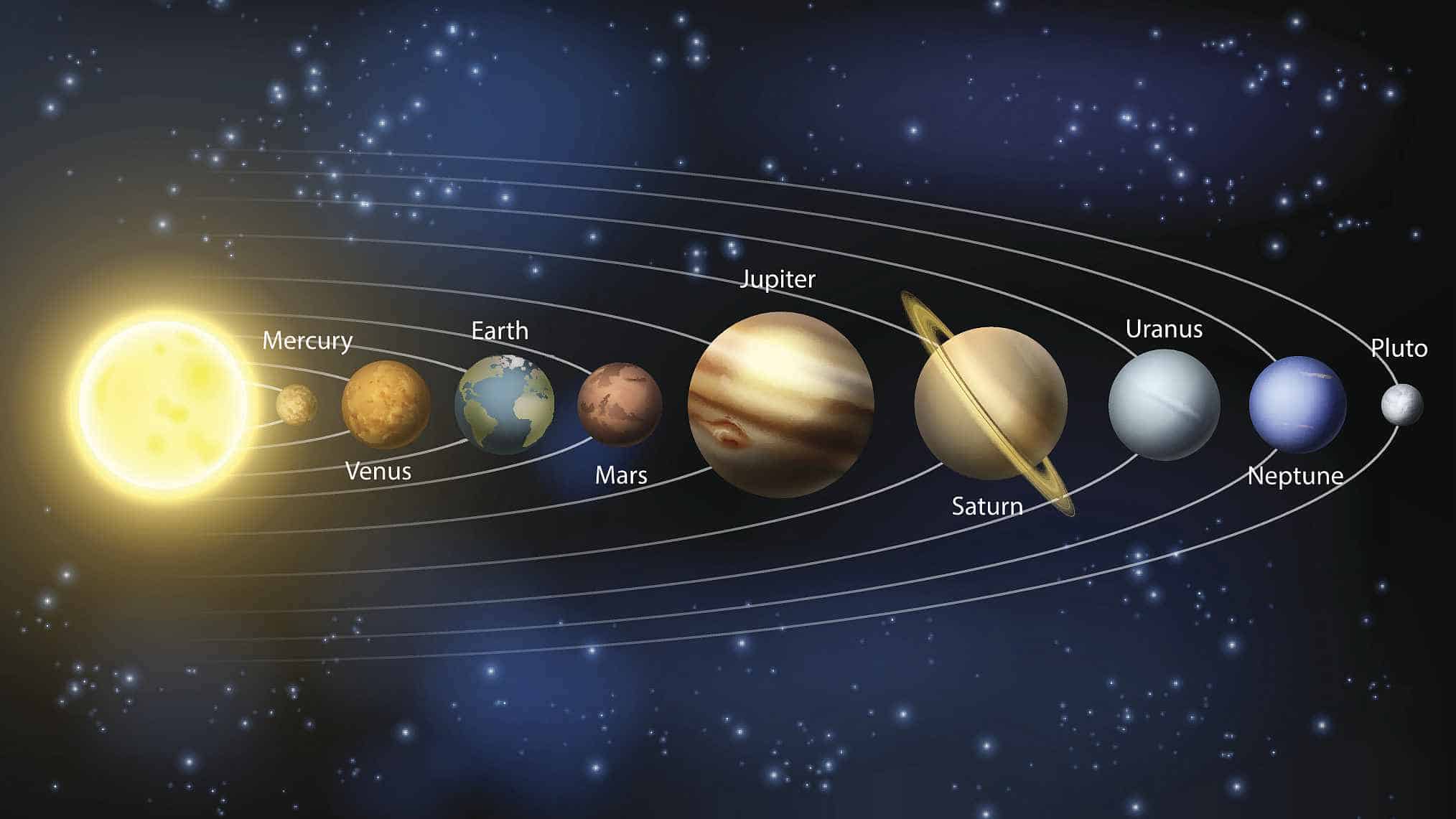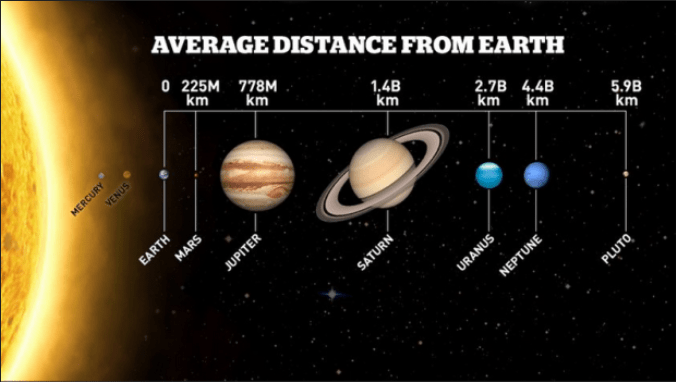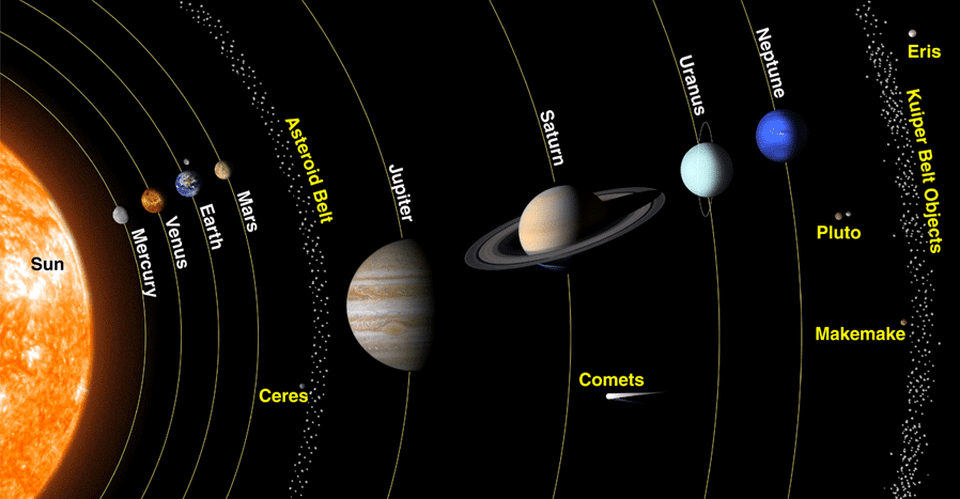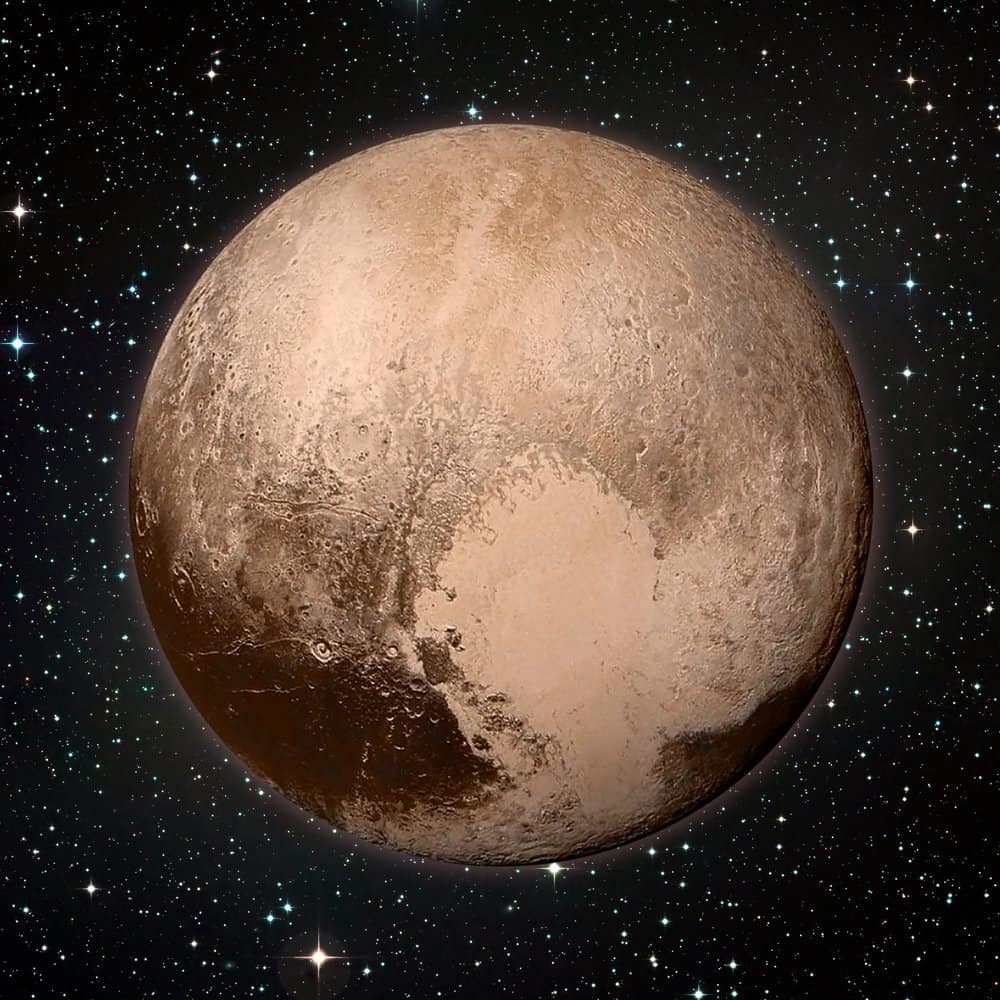You might think that the farthest planet from the Sun, or Earth, is Neptune since Neptune is 30 AU or 4.5 billion km / 2.8 billion mi away from us. However, it is actually Pluto who is the farthest planet from the Sun.
Pluto is, on average, 39.5 AU or 5.9 billion km / 3.7 billion mi away from the Sun. Earth is, on average, 1.00 AU or 150 million km / 93 million mi away from the Sun. So how far is Pluto from Earth?

At its most distant point, when Pluto and Earth are on the opposite sides of the Sun from each other, they are separated by about 7.5 billion km / 4.67 billion mi.
The closest approach of Pluto to Earth is when the dwarf planet is at only 4.28 billion km / 2.66 billion mi from us. This is when Pluto is closer to the Sun than even Neptune.
On average, though, Pluto is 5.05 billion km / 3.1 billion mi away from Earth. This is all due to Pluto’s highly eccentric orbit, which takes it from 30 to 49 AU away from the Sun.
How Long Would It Take to Get to Pluto From Earth?
The distance between Pluto and Earth is, on average, 5.05 billion kilometers / 3.1 billion miles. It is very far away from us. Apart from this, Pluto has an eccentric orbit, which places it either further away or closer to us.

Naturally, we launch a spacecraft towards the planet based upon our predictions of where it will be. Currently, the fastest spacecraft we have developed on Earth was NASA’s New Horizons spacecraft, and it actually reached Pluto in just 9.5 years.
Since technology is always evolving, we might actually get to Pluto even faster than this. It takes a bit of time, but eventually, one of the biggest goals of astronomers is to reduce the time involved in such travels.
How Many Light Years does it Take to Get to Pluto?
Pluto is located at around 263.2 light-minutes away from us. It wouldn’t take a light year to reach it. This is the average distance between Pluto and us, and even at its furthest distance from us, it wouldn’t even get near to a light-year away.

Is Pluto or the Sun Closer to Earth?
The Sun is much more closer to Earth than Pluto. Even when Pluto makes its closest approach to the Sun, it is still farther away from us than the Sun.
The Sun is located at around 1.00 AU or 150 million km / 93 million mi away. Pluto, on its nearest approach to us, is still at a whopping 4.28 billion km / 2.66 billion mi from us. Here is a table with the average distance of all the planets and the Sun:
| Object | Distance From the Sun | Farthest Distance – Aphelion | Closest Distance – Perihelion |
| Mercury | 0.4 AU or 58 million km / 36 million mi | 0.44 AU or 69 million km / 42 million mi | 0.30 AU or 46 million km / 28 million mi |
| Venus | 0.7 AU or 108 million km / 67 million mi | 0.72 AU or 108 million km / 67 million mi | 0.71 AU or 107 million km / 66 million mi |
| Earth | 1.00 AU or 150 million km / 93 million mi | 1.01 AU or 152 million km / 94 million mi | 0.98 AU or 147 million km / 91 million mi |
| Mars | 1.5 AU or 228 million km / 142 million mi | 1.6 AU or 249 million km / 154 million mi | 1.38 AU or 206 million km / 128 million mi |
| Jupiter | 5.2 AU or 778 million km / 484 million mi | 5.45 AU or 816 million km / 507 million mi | 4.95 AU or 740 million km / 459 million mi |
| Saturn | 9.5 AU or 1.5 billion km / 886 million mi | 10.12 AU or 1.5 billion km / 0.9 billion mi | 9.04 AU or 1.3 billion km / 0.8 billion mi |
| Uranus | 19.8 AU or 2.9 billion km /1.8 billion mi | 20.11 AU or 3 billion km / 1.89 billion mi | 18.33 AU or 2.5 billion km / 1.7 billion mi |
| Neptune | 30 AU or 4.5 billion km / 2.8 billion mi | 30.33 AU or 4.54 billion km / 2.8 billion mi | 29.81 AU or 4.46 billion km / 28.5 billion mi |
| Pluto | 39.5 AU or 5.9 billion km / 3.7 billion mi | 49.30 AU or 7.3 billion km / 4.5 billion mi | 29.65 AU or 4.4 billion km / 2.7 billion mi |
Does Pluto Get Sunlight?
Pluto might seem like a very far away planet, and it really is, but does it get any sunlight due to it being so far away? Of course, it does. Pluto gets around1/1600 as much light from the Sun as Earth does.
In fact, due to its eccentric orbit, Pluto behaves similar to a comet. When the dwarf planet gets at its closest point to the Sun, its atmosphere expands, but it also collapses as it moves further away from the Sun.

When Pluto approaches the Sun, its surface ices sublimate, changing from solid to gas, and rises to create a temporal atmosphere. These gases go up from Pluto’s surface to around 1,670 km / 1,037 mi.
This atmosphere is composed mostly out of nitrogen, methane, and carbon monoxide. The light from our Sun reaches Pluto in around 5.5 minutes at its average distance.
Did you know?
- Pluto is the first Kuiper Belt object which was discovered, and it is the largest plutoid. The dwarf planet was discovered in 1930 by astronomer Clyde Tombaugh.
- Pluto was classified as a planet for 75 years, occupying the position of the ninth planet of the Solar System.
- Pluto is the ninth-largest and tenth most massive object currently known to orbit the Sun.
- The famous dwarf planet is mostly made out of ice and rock. It is small when compared to our Moon, being only one-sixth of its mass and one-third of its volume.
- Pluto has five named moons orbiting around it, namely Charon, Styx, Kerberos, and Hydra. The largest moon is Charon, and some consider it a dwarf planet rather than a moon.
- Many believe that Pluto and Neptune will one day collide with each other due to their chaotic orbits. However, this will never happen since their orbits are perfectly aligned to avoid such an incident.
- One day on Pluto is the equivalent of 153 hours, while one year on Pluto is the equivalent of 248 years. This is how long it takes for Pluto to orbit our Sun once.
- The first spacecraft that visited Pluto, NASA’s New Horizons, carried the ashes of Clyde Tombaugh, the man who discovered the dwarf planet.
- Pluto and its biggest moon, Charon, are quite close to each other. This distance is actually the same as from one side of South America to the last side of North America.
Sources:
Image Sources:
- https://news.cgtn.com/news/3d3d514e33456a4e7a457a6333566d54/img/6cfcd6d9cd7d42fea43bbea8d08f2a96/6cfcd6d9cd7d42fea43bbea8d08f2a96.jpg
- https://useruploads.socratic.org/TW6otA5TPmgyFo5GZStg_a.png
- https://www.scienceabc.com/wp-content/uploads/2015/06/Pluto1.jpg
- https://miro.medium.com/max/960/1*G0G4oCnVt-qepOPPMjcsAA.png
